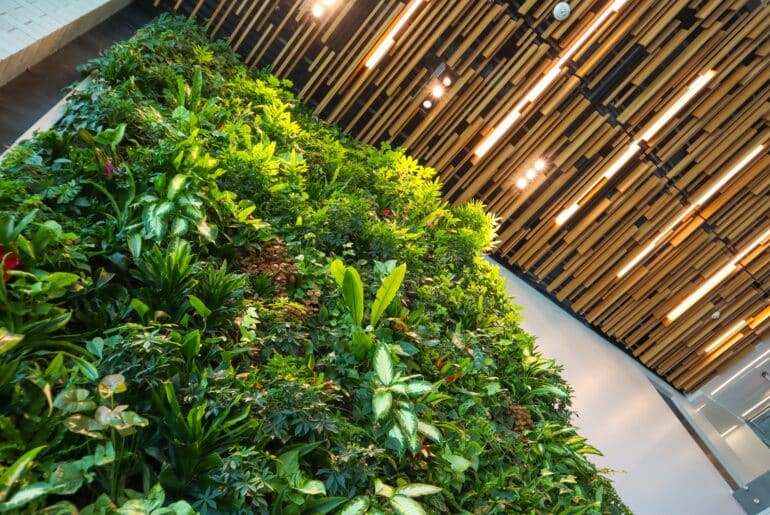Given that buildings account for 39% of CO2 emissions in the United States, one of the foremost objectives in the sustainable building industry is to eliminate or reduce our built environment’s carbon emissions. The question is, how do we work towards carbon neutrality in buildings?
To achieve net zero carbon, there are two factors we need to account for: embodied carbon (which we previously outlined the importance of and actionable strategies for in an article on the role of embodied carbon) and operational carbon. An important step towards eliminating operational carbon is for buildings to go all-electric.
All-electric buildings help reduce carbon emissions in three major ways:
1. As electricity grids continue to modernize and move towards greener energy sources, pursuing all-electric buildings has a bigger impact on reducing operational carbon due to source carbon emission reductions.
2. Energy consumption and energy cost can be better managed by using demand response technologies and peak shaving strategies in all-electric buildings that help reduce site carbon emissions.
3. Integrating on-site renewable electricity generation into projects is an easier way to further help offset purchased electricity, thereby reducing source carbon emissions.
By carefully selecting appropriate strategies, all-electric buildings on a wide scale can be cost effective in the long-term while mitigating climate change. Consider the following measures for renewable energy generation and storage, as well as how to actually begin implementing net zero operational carbon goals, to bring all-electric buildings to life.
RENEWABLE ENERGY GENERATION: A POWERFUL SHIFT
While installing renewable electricity generation systems has become more prevalent, changing the make-up of the electricity grid can have a larger impact on carbon reductions. Taking advantage of renewable sources of energy such as solar, wind, water, and geothermal energy can catalyze a paradigm shift from the current electric grid to a sustainable solution.
These renewable energy sources are triggering a transformation in the power sector, making far-reaching opportunities of decarbonized, electrified buildings much more achievable. Some areas have already proven that new unsubsidized wind and solar energy is cheaper than natural gas and will only continue down that path as more innovations roll out, particularly when related to energy storage.
ENERGY STORAGE: BUILDINGS AS BATTERIES
As energy storage technologies continue to advance drastically and increase in affordability, there is greater feasibility to store energy that is generated by wind and solar farms, regardless of demand. New technology such as hardware solutions, energy efficiency control devices, and smart grid advancements are designed to reduce peak power consumption and store energy. This stored energy can then be released when needed, providing a flow of clean energy during periods of high demand or when renewable energy sources aren’t available.
Today’s electricity grid has minimal storage, which limits the usability of renewable energy produced at the grid level during hours where production levels are low. Enactments of more affordable advanced energy technologies can provide grid and consumer benefits if they are fully considered in resource and grid planning.
ALL-ELECTRIC IMPLEMENTATION: DESIGNING MORE EFFICIENT BUILDING SYSTEMS
While there’s much to be done in the policy and technology realms, you can still take initial action towards transitioning to decarbonization through your projects.
The most common gas-fired barriers project teams typically face when trying to implement all-electric buildings include heating, kitchens, and fireplaces. Gas-fired boilers have traditionally been far more prevalent for building heating systems, and it is challenging for facilities teams to learn to maintain new all-electric boilers. In kitchens, occupants generally prefer gas stoves over electric ones due to their refined temperature ranges, making it difficult to convince teams to make the switch. Similarly, the hospitality industry is accustomed to gas-fired ornamental fireplaces, so excluding them from hotel designs can be an uncomfortable ask.
Quantifying the benefits of making the switch to electrification is an effective way to work with project teams through the above challenges. Bold steps are necessary for projects to achieve net zero operational carbon goals and using an energy model to quantify the impact of proposed changes ensures confidence in the design for the entire team.
Thus, it’s critical to involve an energy modeler and make design decisions during the beginning of the design process. Beyond outlining the quantified benefits of all-electric design decisions, they can provide essential guidance in both choosing more efficient system types and further optimizing these systems’ performance to result in a greater reduction of carbon emissions. Once an energy modeler is engaged, they can help determine system selection and run system optimization studies for maximum performance to eliminate operational carbon emissions.
Through analysis and implementation of what performance energy modeling and energy efficiency auditing can be applied, we can begin transitioning out of the gas distribution system to an increasingly low-carbon electric grid, resulting in an efficient building process and a reduction of your project’s carbon footprint.
To learn more about all-electric buildings and discuss how to move your project toward carbon neutrality, contact our team.


